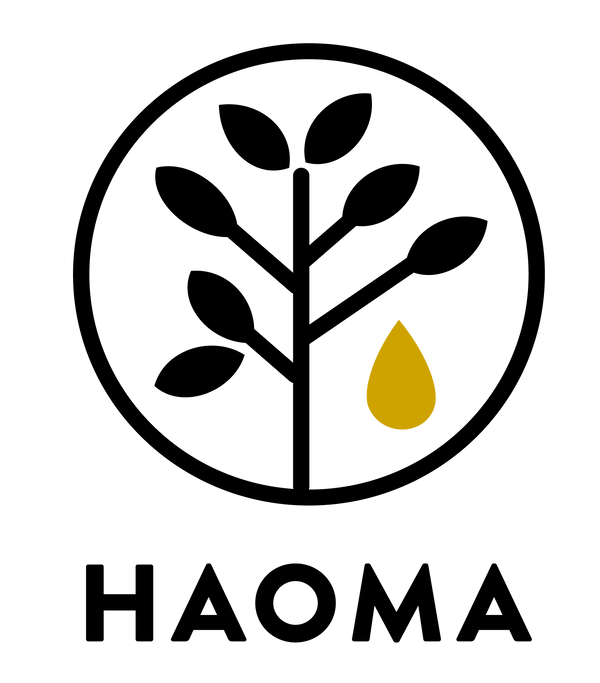Emulsifiers
Most people feel their skin is tight and dry after cleansing and they need to apply a moisturiser twice a day because their skin feels dry. This is due to the ‘wash-out’ effect of emulsifiers.
Emulsifiers can impair our trans-epidermal water loss and lipid dryness but they are still one of the most common ingredients in cosmetic products. Here at Haoma we never use emulsifiers in any of our products, but why do all other companies use them?
Their use is considered an easy and inexpensive way of combining the oil and water parts of a cream or lotion, so that they don’t separate. What we recommend instead is to simply shake your Haoma products before each use.
Emulsifiers are called surfactants when they are inside products other than cleaning products. The molecular structure of the emulsifier is the same one that makes soaps and detergents very good at cleansing our skin. We believe having a detergent-like molecule in your moisturiser is not going to be very good for your skin! Of greatest concern is their potential to damage the skin’s barrier, which is made up of specialised proteins and lipids. Disrupting the skin’s barrier can lead to increased water loss from the skin, and the entry of microorganisms and irritants into the skin that may potentially result in inflammation and irritation.
All emulsifiers have the same basic detergent-like structure however they are divided into 3 types.
- Anionic emulsifiers with the greatest potential to disrupt the lipids and proteins in the skin.
The classic example is sodium lauryl sulphate, a known skin irritant.
- Cationic emulsifiers can bind to the protein keratin which is located in the outer layer of the skin and because of this capacity to bind to the skin, they also have the potential to cause skin irritation, mainly due to toxic effects on skin cells.
Examples of cationic emulsifiers include benzalkonium chloride and behentrimonium methosulphate.
- Non-ionic emulsifiers are considered less irritating than anionic and cationic surfactants, however some of them have been shown to interact with skin lipids, disrupting the skin’s barrier function and increasing loss of water from the skin.
Examples of nonionic emulsifiers include cetearyl alcohol, stearic acid, glyceryl stearate and ceteareth-20.
In summary:
- The properties of emulsifiers vary by type and can be very irritating to the skin, even more than fragrance or preservatives.
- Most skin care including shampoos, body washes as well as dishwashing liquids and toothpaste contain irritating emulsifiers because of the cleaning properties and high foaming potential.
- Quite scarily emulsifiers do not lose their emulsifying abilities in the skin, so they wash out the good of your skin, especially when your skin comes in contact with water.
- Emulsifiers alter and lower the ability of our skin barrier to defend itself against outside elements.
Preservatives
Preservatives are required by law to be included in cosmetics with water-containing formulations. Most products on the market have water as their main ingredient - look at the labels and you will see ‘Aqua’ usually being the first ingredient in the ingredients list - as ingredients have to be declared in descending order by volume. Water based formulations are highly preferred due to water being the cheapest ingredient in any formulation.
Preservatives are essential ingredients in formulations containing water as they stop products from becoming contaminated with bacteria, mould and fungus etc.
Here at Haoma we really want to change the age-old rules and practices in the cosmetics industry. We always look for ways to formulate our products in a way that they do not require preservatives at all. When there is no water there is no requirement to use a preservative as the products would not get contaminated.
Some of our products however contain ingredients that act as preservatives in addition to their original purpose. Most essential oils are a very good example of this, they contain antibacterial and anti-fungal properties that can act as a preservative. Fair-trade, organic sugarcane alcohol, we use as a base in some of our formulations to solubilise the essential oils, also have antibacterial qualities.
Now let’s have a look at some natural companies that sell products containing preservatives, the preservatives they use are usually called ‘natural’, ‘plant-based’, ‘plant-derived’…
It is really important to look at the derivation process rather than the source in these examples. This topic has been explained in detail in FAQ ‘What do you mean your products do not contain processed and plant-derived ingredients?’
For example, grapefruit seed extract is used as a preservative in many products. It sounds so natural and even preferable however Skin Deep database rates it 6 out of 10, 10 being the most toxic.
While some skincare products' preservatives are more controversial than others, no preservatives are good for us and it is best to avoid them by purchasing skin care formulations that do not require preservatives. It is important to be very cautious about natural preservatives that may be as concerning as synthetic ones.


